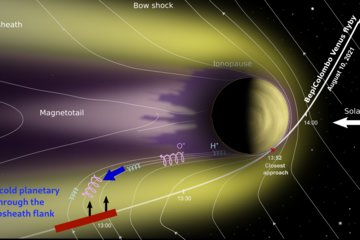All genres
21.
Journal Article
Reversed plasma convection flow in the polar ionosphere from EISCAT radar observations. Chinese J. Geophys. 44 (4), pp. 444 - 451 (2002)
22.
Journal Article
Global ULF disturbances during a stormtime substorm on 25 September 1998. Journal Geophysical Research 107 (A12), 1486 (2002)
23.
Journal Article
Das Weltraumwetter und seine Auswirkungen. Astronomie und Raumfahrt im Unterricht 39 (5), pp. 15 - 18 (2002)
24.
Journal Article
Sonnenaktivität und Klima. Meteoros 5, pp. 148 - 167 (2002)
25.
Journal Article
50 Jahre Schumann-Resonanzen - Weltweite Ortung von Blitzen. Physik in unserer Zeit 33 (6), pp. 256 - 261 (2002)
26.
Journal Article
A D-region conductivity model from EISCAT VHF measurements. Annales Geophysicae 20 (9), pp. 1439 - 1445 (2002)
27.
Journal Article
High-latitude ground-based observations of the thermospheric ion-drag time constant. Geophysical Research Letters 28 (7), pp. 1395 - 1398 (2001)
28.
Journal Article
Diurnal, seasonal, and geomagnetic variations of large field-aligned ion upflows in the high-latitude ionospheric F region. Journal Geophysical Research 106 (A11), pp. 24651 - 24661 (2001)
29.
Journal Article
Equinoctial transitions in the ionosphere and thermosphere. Annales Geophysicae 19 (7), pp. 783 - 796 (2001)
30.
Journal Article
Die Magnetosphäre der Erde. Astronomie und Raumfahrt im Unterricht 38 (3), pp. 31 - 34 (2001)
31.
Journal Article
Polarlicht. Praxisheft für Amateurfunk und Elektronik in Schule und Freizeit, Arbeitskreis Amateurfunk und Telekommunikation in der Schule 11, pp. 51 - 53 (2001)
32.
Journal Article
Thunderstorms, lightning and solar activity - Middle Europe. Journal of Atmospheric and Solar-Terrestrial Physics 63, pp. 1705 - 1713 (2001)
33.
Journal Article
Sonnenwind und Weltraumwetter. Spektrum der Wissenschaft, Dossier 3, pp. 15 - 23 (2001)
34.
Journal Article
Leuchterscheinungen am Himmel über See und Land. Trans-Ocean 93, pp. 28 - 33 (2001)
35.
Journal Article
Combined EISCAT and Fabry-Perot interferometer measurements of ionospheric-thermospheric coupling. Phys. Chem. Earth (B) 25, pp. 563 - 566 (2000)
36.
Journal Article
(B) - Direct calculation of F-region Joule heating from simultaneous ion and neutral measurements at high latitudes. Phys. Chem. Earth (B) 25 (5-6), pp. 439 - 442 (2000)
37.
Journal Article
Ion-neutral coupling in the high-latitude F-layer from incoherent scatter and Fabry-Perot interferometer measurements. Annales Geophysicae 18 (9), pp. 1145 - 1153 (2000)
38.
Journal Article
Radio backscatter studies in South Europe of the Midlatitude E Region Ionosphere. The Radio Science Bulletin 295, pp. 6 - 14 (2000)
39.
Journal Article
Auroral E-region electron density gradients measured with EISCAT. Annales Geophysicae 18 (9), pp. 1172 - 1181 (2000)
40.
Journal Article
Penetration of auroral electric fields to the equator during a substorm. Journal Geophysical Research 105, pp. 23251 - 23261 (2000)











